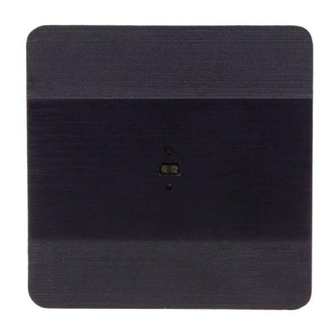Advertisement
Quick Links
DRL-60-12
Laser distance sensor,
Do not dispose of this device in the trash along with other waste!
According to the Law on Waste, electro coming from households free of charge and can
give any amount to up to that end point of collec� on, as well as to store the occasion of
the purchase of new equipment (in accordance with the principle of old-for-new, regard-
less of brand). Electro thrown in the trash or abandoned in nature, pose a threat to the
environment and human health.
Purpose
The DRL-60-12 is a laser sensor designed to control lighting,
especially in corridors and staircases.
The principle of operation is to emit a light beam and measu-
re the delay of returning light as a result of reflection from an
obstacle. On this basis, it is possible to precisely determine the
distance to the obstacle, which is then compared with the set
detection range.
The condition for switching on the light is the presence of an
obstacle at a distance smaller than the set detection range and a
brightness level below the value set on the sensor.
This solution is perfect for switching on lighting circuits for exam-
ple on open stairs, where it is important that the sensor detects
presence only on the stairs and ignores everything that happens
outside.
F&F Filipowski L.P.
Konstantynowska 79/81, 95-200 Pabianice, POLAND
phone/fax (+48 42) 215 23 83 / (+48 42) 227 09 71
www.fif.com.pl; e-mail: biuro@fif.com.pl
12 V
- 1 -
Advertisement

Subscribe to Our Youtube Channel
Summary of Contents for F&F DRL-60-12
- Page 1 Electro thrown in the trash or abandoned in nature, pose a threat to the environment and human health. Purpose The DRL-60-12 is a laser sensor designed to control lighting, especially in corridors and staircases. The principle of operation is to emit a light beam and measu- re the delay of returning light as a result of reflection from an obstacle.
- Page 2 Features » Laser distance sensor of the ToF (Time of Flight) type; » The detection range can be smoothly adjusted in the range of 0.1 to 2 m; » A brightness sensor that prevents the light from being swit- ched on when the brightness level is high; »...
- Page 3 Failure to observe safety distances may lead to unwan- ted sensor excitation. 2. Do not mount the sensor with the front-facing a strong light source, as this may lead to incorrect operation of the distance and light intensity measurement system. 3.
-
Page 4: Description Of Control Terminals
6. Attach the mounting frame to the box using screws or claws. 7. Connect the DRL-60-12 according to the selected wiring diagram. When selecting the cable cross-section in low-voltage installations, it is necessary to take into account the vol- tage drop on the cables related to the length and load of the cable. - Page 5 – Sensor power supply 0 V Lighting control output The DRL-60-12 is equipped with an open collector type output. This means that the lighting to be controlled must be connected between the "+" of the power supply and the OUT output of the controller.
- Page 6 Knob Range Function Setting the sensor detection range. If an obstacle appears at a distance DIST 0.1÷2.0 m shorter than that set by the knob, the lighting will be switched on (if the illumination condition is also met). Brightness level setting. If the light intensity is lower than the 2÷500 Lx value set by the knob, the light will swi-...
- Page 7 Connection diagram Direct connection of lighting If it is necessary to control a load greater than 4 A, the LED-AMP-1P signal amplifiers (mounting in an installation box ø60) or LED-AMP-1D (mounting on a DIN rail) should be used. An example connection diagram can be found on the product subpage at www.fif.com.pl - 7 -...
- Page 8 Connection of the AS-225 cascade controllers - 8 -...
- Page 9 Signalisation The DRL-60-12 sensor is equipped with an LED on the front of the device, which indicates the operating status of the device: Sensor on standby, no obstacles in the detection area. An obstacle in the detection area has been detected. The light was not switched on because the brightness level was too high.
-
Page 10: Technical Data
Too high temperature can be caused by connecting a too high load to the sensor. The brightness level of the signal LED adjusts to the am- bient brightness (high ambient brightness – high LED bri- ghtness level). When an overtemperature is indicated, the light flashes at maximum brightness. -
Page 11: Warranty
Warranty The F&F products are covered by a warranty of the 24 months from the date of purchase. Effective only with proof of purchase. Contact your dealer or directly with us. CE declaration F&F Filipowski L.P. declares that the device is in conformity with the essential requirements of The Low Voltage Directive (LVD) 2014/35/EU and the Electromagnetic Compatibility (EMC) Directive 2014/30/UE.










Need help?
Do you have a question about the DRL-60-12 and is the answer not in the manual?
Questions and answers